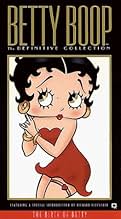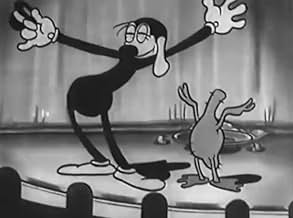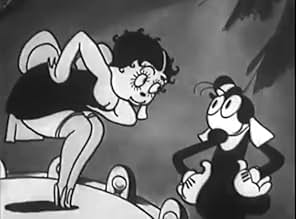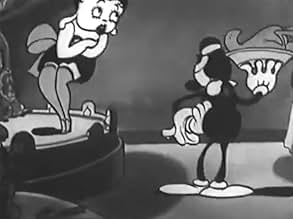Füge eine Handlung in deiner Sprache hinzuBetty Boop (with dog's ears) is entertainer in a restaurant for dogs; a waiter joins the floor show to the neglect of patrons.Betty Boop (with dog's ears) is entertainer in a restaurant for dogs; a waiter joins the floor show to the neglect of patrons.Betty Boop (with dog's ears) is entertainer in a restaurant for dogs; a waiter joins the floor show to the neglect of patrons.
William Costello
- Gus Gorilla
- (Synchronisation)
- (Nicht genannt)
Margie Hines
- Betty Boop
- (Synchronisation)
- (Nicht genannt)
- …
Billy Murray
- Bimbo
- (Synchronisation)
- (Nicht genannt)
Walter Scanlan
- Customers
- (Nicht genannt)
Empfohlene Bewertungen
Betty Boop to this day remains one of the most cherished cartoon characters of the 20th century, if not of all time. If it weren't for her spunk personality, charming physique and surreal tone, who knows what non-Disney animation would have been like back then. However, when it comes to her first ever appearance, that being the cartoon Dizzy Dishes, it's far from anything great.
Now the cartoon does credit Grim Natwick as the lead animator, and rightfully so as he actually created Betty Boom herself, or at least this can be deemed a prototype. As she was modeled after Helen Kane and Esther Jones, Natwick really knew how to bring this lustrous femme to life through broad animation and bizarre proportions. Even though Max Fleischer took credit, it's always a bonus to give praise to the true man who crafted the og version of Betty that led her to stardom. Also, as this cartoon was made in the early 1930s, it is very fun to see the days where almost every cartoon embraced the surrealistic attributes of visual comedy.
Sadly, that's where my positives end. Although most of the negatives I have for this cartoon are more based off the severe limitations of silent filmmaking back then, they still need to be addressed. For one thing, the sound quality is so bad that it's near impossible to comprehend what the others are saying (even Betty's own song for goodness sake). Plus, the animation is inconsistent and jerky, the jokes don't really hit that well, and even the bouncy feel of cartoon animation back then isn't as thrilling as it sounds here.
And then there's the actual storyline itself. The main character, who would later become Betty's sidekick Bimbo, is a waiter who needs to prepare a roast duck for a hungry customer. However, he gets caught up in the dancing fun to the point where the customer gets aggressively uptight at him. Maybe I'm thinking too much about this, but that customer has every right to be angry at that dog. How much free time can one dog have before it bites him in the butt? Regardless, while I do admire this cartoon for being Betty's first unofficial appearance, I can't get into it because of how little it entertains me.
Now the cartoon does credit Grim Natwick as the lead animator, and rightfully so as he actually created Betty Boom herself, or at least this can be deemed a prototype. As she was modeled after Helen Kane and Esther Jones, Natwick really knew how to bring this lustrous femme to life through broad animation and bizarre proportions. Even though Max Fleischer took credit, it's always a bonus to give praise to the true man who crafted the og version of Betty that led her to stardom. Also, as this cartoon was made in the early 1930s, it is very fun to see the days where almost every cartoon embraced the surrealistic attributes of visual comedy.
Sadly, that's where my positives end. Although most of the negatives I have for this cartoon are more based off the severe limitations of silent filmmaking back then, they still need to be addressed. For one thing, the sound quality is so bad that it's near impossible to comprehend what the others are saying (even Betty's own song for goodness sake). Plus, the animation is inconsistent and jerky, the jokes don't really hit that well, and even the bouncy feel of cartoon animation back then isn't as thrilling as it sounds here.
And then there's the actual storyline itself. The main character, who would later become Betty's sidekick Bimbo, is a waiter who needs to prepare a roast duck for a hungry customer. However, he gets caught up in the dancing fun to the point where the customer gets aggressively uptight at him. Maybe I'm thinking too much about this, but that customer has every right to be angry at that dog. How much free time can one dog have before it bites him in the butt? Regardless, while I do admire this cartoon for being Betty's first unofficial appearance, I can't get into it because of how little it entertains me.
While Fleischer cartoons are generally well-animated and thus worth watching from that standpoint, the only real point of interest is the comparatively brief look at Betty Boop-version 1.0. Originally, Betty Boop was conceived as a dog and gradually evolved into the Betty Boop most recognizable today. There isn't much to say about the short itself, as it's nothing terribly special. The gags are occasionally cute, but it isn't especially memorable for anything other than Betty. I've had waiters this bad before, however. Dizzy Dishes is on Betty Boop-The Definitive Collection, an excellent compilation. Maybe Popeye will receive similar treatment on DVD sometime before the heat-death of the universe. For completeists only.
Dizzy Dishes (1930)
** 1/2 (out of 4)
This is a somewhat forgettable short but it does have one historically important thing that makes it worth watching. The story is quite simple as everyone in the film is a dog character and we are treated to our main character, a waiter, who is falling behind at work. That's until he walks out into the lobby where we see what would be the first appearance of Betty Boop. DIZZY DISHES isn't all that good as there aren't any laughs and the story itself is nothing special. The reason people will want to watch this is that it does feature the first appearance of Betty Boop, although she doesn't look like she eventually would. She has dog ears here and is a lot taller than what most people think of her as. Fans of Betty will want to check this out even though it doesn't offer much else.
** 1/2 (out of 4)
This is a somewhat forgettable short but it does have one historically important thing that makes it worth watching. The story is quite simple as everyone in the film is a dog character and we are treated to our main character, a waiter, who is falling behind at work. That's until he walks out into the lobby where we see what would be the first appearance of Betty Boop. DIZZY DISHES isn't all that good as there aren't any laughs and the story itself is nothing special. The reason people will want to watch this is that it does feature the first appearance of Betty Boop, although she doesn't look like she eventually would. She has dog ears here and is a lot taller than what most people think of her as. Fans of Betty will want to check this out even though it doesn't offer much else.
The Best thing about this talkartoon feature was it the first cartoon to feature the animated character Betty Boop. Betty was nameless in this feature and was Originally meant as a Caricature of Helen Kane. she most likely was meant to have been Helen kane only in a cartoon form and thats why she was nameless also not to mention Betty Boop was a canine.
to avoid confusion margie hines was the first helen kane soundalike chosen to record the singing for this cartoon meaning she was first to voice Betty Boop.
The Caricature Performs one of Helen kanes Novelty Hits (I Have To Have You) with some scat lyrics of Boop Oop a Doop/ Poop Poop a Doo/ Boop Boop a Doop. the cartoon has the regular fleischer studio Gags. basically revolving around bimbo the dog. Gus the gorilla can also be seen in this short who was actually one of the characters from the Betty Boop series. Betty boops singing doesn't last very long but its great to see all the expressions in her face, some are really scary. if only her sequence went on longer.
I give this cartoon 10/10 because it was the first cartoon to feature Betty Boop. she was classed as ugly in this appearance but sooner or later she went though a few more changes which resulted in her becoming the title name called The Betty Boop Cartoons.
to avoid confusion margie hines was the first helen kane soundalike chosen to record the singing for this cartoon meaning she was first to voice Betty Boop.
The Caricature Performs one of Helen kanes Novelty Hits (I Have To Have You) with some scat lyrics of Boop Oop a Doop/ Poop Poop a Doo/ Boop Boop a Doop. the cartoon has the regular fleischer studio Gags. basically revolving around bimbo the dog. Gus the gorilla can also be seen in this short who was actually one of the characters from the Betty Boop series. Betty boops singing doesn't last very long but its great to see all the expressions in her face, some are really scary. if only her sequence went on longer.
I give this cartoon 10/10 because it was the first cartoon to feature Betty Boop. she was classed as ugly in this appearance but sooner or later she went though a few more changes which resulted in her becoming the title name called The Betty Boop Cartoons.
Besides Walt Disney, the Fleischer brothers, Max and Dave, were one of the main producers of animated cartoons in the early 1930s. Much of their success could be attributed to a flapper gal who began her career as a cross between a dog and a female singer. Her name: Betty Boop.
Betty's debut was in August 1930's "Dizzy Dishes" where she's singing a brief song that includes her soon-to-be famous catchphrase 'Boop-Oop-a-doop.' Her birth in film was just an afterthought. "Dizzy Dishes" main character was Bimbo the Pup. Betty doesn't appear until around the six minute mark, while Bimbo, whose name was derived from the term at that time to mean men who like to fight, was seen right from the beginning. "Dizzy Dishes" was part of a 42-cartoon series, labeled 'Talkartoons' that augmented Fleischer Studio's earlier "Screen Songs" series. Those musical animations morphed from the even earlier 'Ko-Ko the Clown" cartoons, who emerged from the 1918 'Out of the Inkwell" series. Ko-Ko later was featured in the follow-the-bouncing-ball films with songs featuring the clown, one of cartoon's first short films with a sound track. Bimbo the Pup was born in that string of cartoons because the Fleischers felt their clown needed a pet.
The Fleischers turned to Bimbo to headline their new Talkartoons. The dog's first lead role was in March 1930's 'Hot Dog.' In Bimbo's seventh featured cartoon, "Dizzy Dishes," Bimbo plays a stressed waiter who can't please anyone in a busy restaurant. While he's serving a table with food, he spots cabaret singer Betty on the stage. She appears as a human, but with a button dog nose, long puppy ears and Cocker Spaniel-like eyes. Betty was drawn to appeal to Bimbo. It was over a year, in January 1932's "Any Rags," before Betty dropped the dog ears, turning them into human with large earrings while she became more feminized.
Max told his animators to pattern the flapper dog Betty after actress singer Helen Kane. The likeness to the movie star was so obvious that Kane sued the Fleischers in 1932 in a $250,000 infringement lawsuit. The actress' case was based on her singing style and her "Boop-Oop-a-doop" signature phrase. The Fleischers refuted Kane's claims by pointing to Harlem singer Esther Jones, a.k.a. Baby Esther, who originated Betty Boop's trademark stanza. Turns out Kane had adopted Jones' singing style and claimed it was her own. The judge agreed with the cartoon studio's contention that Betty Boop was a combination of several singing artists.
Betty's debut was in August 1930's "Dizzy Dishes" where she's singing a brief song that includes her soon-to-be famous catchphrase 'Boop-Oop-a-doop.' Her birth in film was just an afterthought. "Dizzy Dishes" main character was Bimbo the Pup. Betty doesn't appear until around the six minute mark, while Bimbo, whose name was derived from the term at that time to mean men who like to fight, was seen right from the beginning. "Dizzy Dishes" was part of a 42-cartoon series, labeled 'Talkartoons' that augmented Fleischer Studio's earlier "Screen Songs" series. Those musical animations morphed from the even earlier 'Ko-Ko the Clown" cartoons, who emerged from the 1918 'Out of the Inkwell" series. Ko-Ko later was featured in the follow-the-bouncing-ball films with songs featuring the clown, one of cartoon's first short films with a sound track. Bimbo the Pup was born in that string of cartoons because the Fleischers felt their clown needed a pet.
The Fleischers turned to Bimbo to headline their new Talkartoons. The dog's first lead role was in March 1930's 'Hot Dog.' In Bimbo's seventh featured cartoon, "Dizzy Dishes," Bimbo plays a stressed waiter who can't please anyone in a busy restaurant. While he's serving a table with food, he spots cabaret singer Betty on the stage. She appears as a human, but with a button dog nose, long puppy ears and Cocker Spaniel-like eyes. Betty was drawn to appeal to Bimbo. It was over a year, in January 1932's "Any Rags," before Betty dropped the dog ears, turning them into human with large earrings while she became more feminized.
Max told his animators to pattern the flapper dog Betty after actress singer Helen Kane. The likeness to the movie star was so obvious that Kane sued the Fleischers in 1932 in a $250,000 infringement lawsuit. The actress' case was based on her singing style and her "Boop-Oop-a-doop" signature phrase. The Fleischers refuted Kane's claims by pointing to Harlem singer Esther Jones, a.k.a. Baby Esther, who originated Betty Boop's trademark stanza. Turns out Kane had adopted Jones' singing style and claimed it was her own. The judge agreed with the cartoon studio's contention that Betty Boop was a combination of several singing artists.
Wusstest du schon
- WissenswertesBetty Boop, as an unnamed dog, makes her first appearance in this cartoon. In later films, she loses the dog ears and becomes the familiar human character.
- Zitate
Gus Gorilla: [Gus Gorilla] Where's MY roast duck?
- VerbindungenEdited into Betty Boop Confidential (1998)
- SoundtracksAbaloney
(uncredited)
Traditional
Sung during the opening credits
Top-Auswahl
Melde dich zum Bewerten an und greife auf die Watchlist für personalisierte Empfehlungen zu.
Details
- Laufzeit6 Minuten
- Farbe
- Sound-Mix
- Seitenverhältnis
- 1.37 : 1
Zu dieser Seite beitragen
Bearbeitung vorschlagen oder fehlenden Inhalt hinzufügen















